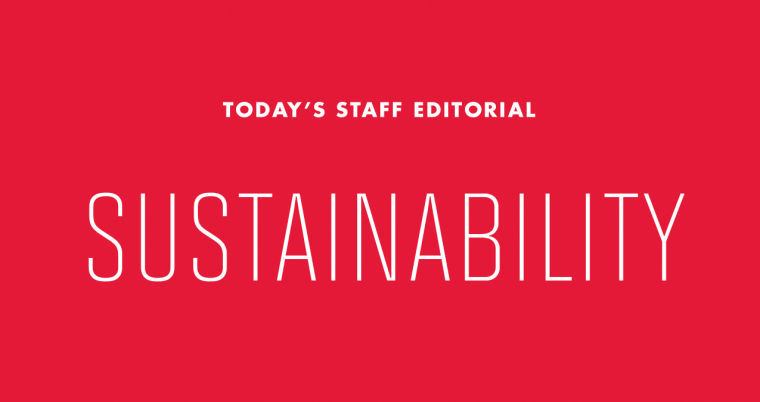
Spending on sustainability
Last Thursday, the University Sustainability Fund granted $50,000 to Facilities Management to create green amenities in the new Edward St. John Learning and Teaching Center. The building, set to open in 2016, will include either a teaching green roof or a rainwater harvesting system, but Facilities Management has not decided which project, if not both, to implement yet.
Although the details of the two Facilities Management projects have not completely rolled out, we support allocating these funds toward features meant to improve the campus academically and environmentally. Though the program costs $50,000, we believe the benefits generally outweigh the costs.
The teaching green roof and the rainwater harvesting system both serve academic purposes, not just environmental ones. The teaching green roof provides a backdrop for an applied education — students can easily access the roof and take classes or study there. Meanwhile, the harvesting system provides benefits beyond simple sustainability because it would provide research and teaching opportunities for students and faculty on the campus.
One of this university’s most important goals is to be a leading institution in environmental research and sustainability. Although we must be cautious and ensure student funds aren’t going to green projects that have extensive costs or only benefit a small proportion of the university community, the benefits provided by these projects are easily accessible and contribute to compelling academic purposes.
If people are wary of the financial costs, then this must be dealt with through the University Sustainability Council — after all, we did vote for this. In April 2007, a whopping 91 percent of undergraduate students voted in favor of increasing student fees by $12 per year to create a University Sustainability Fund. This fund, which totaled $350,000 this year, is responsible for granting different portions of its budget to green initiatives on the campus. University students favored the creation of this endowment as a means to make the campus more environmentally self-sufficient.
The University Sustainability Fund requires anyone seeking a grant to complete a rigorous application. Organizations and departments must pitch a program that satisfies a total of 14 requirements to receive grant money. These requirements include having a broad application across the campus, measurable outcomes, mechanisms for project evaluation and follow-up, education and outreach opportunities, a cost-benefit analysis outline and support from different individuals and entities on the campus.
Once an individual, group or department pitches the program, the University Sustainability Council assesses the proposed program’s ability to meet its specified requirements and then makes the final decisions. The council receives input from the Student Advisory Subcommittee, which reviews all applications and makes recommendations to the council before any official decisions are made.
Achieving environmental goals at a university level is done best when they meet academic needs and affect a large portion of the student body. Just because we support being environmentally friendly does not mean we support public funding for unnecessary programs that serve more to show off our green initiatives than actually put them to use. At the end of the day, we support the University Sustainability Council’s decisions on academic and environmental grounds — the teaching green roof and rainwater harvesting system will save water, reduce our carbon footprint and expand our research and educational opportunities more than we could have imagined.



